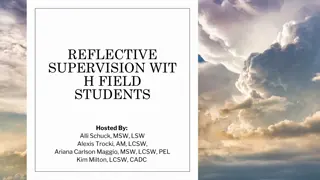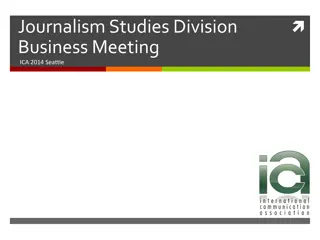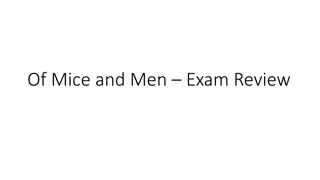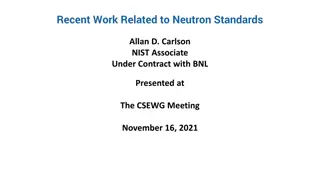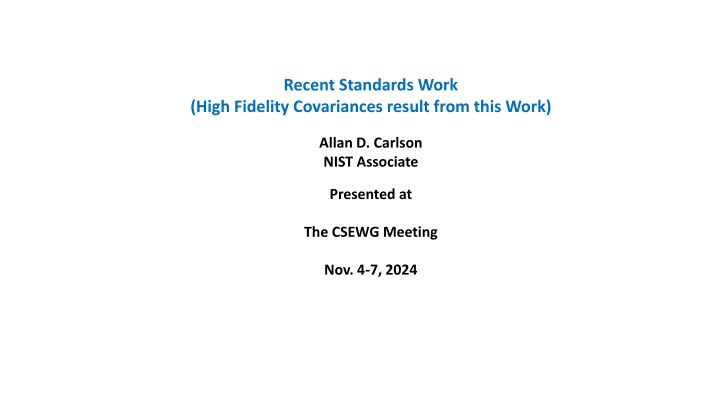
Recent Developments in Neutron Standards Research
Explore recent advancements in neutron standards research, including high-fidelity covariances and cross-section measurements for various isotopes. Discover new methods and experimental data contributing to the understanding of systematic uncertainties in neutron measurements.
Download Presentation

Please find below an Image/Link to download the presentation.
The content on the website is provided AS IS for your information and personal use only. It may not be sold, licensed, or shared on other websites without obtaining consent from the author. If you encounter any issues during the download, it is possible that the publisher has removed the file from their server.
You are allowed to download the files provided on this website for personal or commercial use, subject to the condition that they are used lawfully. All files are the property of their respective owners.
The content on the website is provided AS IS for your information and personal use only. It may not be sold, licensed, or shared on other websites without obtaining consent from the author.
E N D
Presentation Transcript
Recent Standards Work (High Fidelity Covariances result from this Work) Allan D. Carlson NIST Associate Presented at The CSEWG Meeting Nov. 4-7, 2024
Outline of Recent Work on the Neutron Standards Measurements of Neutron Cross Section Standards Proposed, Underway or Completed. Including results presented at the Oct 2023 Standards meeting. Due to time limitations for this presentation mostly very recent work will be discussed. The reference cross section areas below will not be shown: Prompt -ray production Reference cross section measurements. 7Li(n, n ) and 48Ti(n,n ) Reference cross sections. There is an emphasis on encouraging experiments using new methods for obtaing data to help the understanding of unrecognized systematic uncertainties.
The thermal constants are the responsibility of the standards group because they are accurately known. A non-cross section thermal constant used as a standard is --------- The subject of Denise s talk
6Li(n,t) Measurements New measurements were made of the 6Li(n,t) cross section relative to the 235U(n,f) standard at IPPE by Prusachenko. A pulsed quasi-monoenergetic neutron beam from the 2H(d,n)3He reaction was used to obtain measurements for energies from 4.75 to 7.5 MeV. Though these data are significantly above the present standards energy region, they will have an impact through the use of R-Matrix analyses and can possibly allow extension of the standard.. Measurements are being made by Anastasiou et al. of the 235U(n,f)/6Li(n,t) cross section ratio with the NIFFTE fission TPC. The expected energy range is from about 0.1 MeV up to 3 MeV (possibly 4 MeV). The data will impact evaluations of both the 235U(n,f) and 6Li(n,t) cross sections. Some results of this work were given by Anastasiou at the ND2022 conference and the 2023 standards meeting . The present results are very preliminary.
6Li(n,t) and 10B(n, ) and 10B(n, ) Measurements at CSNS Extensive measurements of the 6Li(n,t) angular distribution by Bai et al. for energies from 1 eV to 3 MeV Angular distribution data were also obtained by Jiang et al. for the boron standards from 1 eV to 2.5 MeV For both of these experiments there are some concerns due to the use of the 235U(n, f) cross section for fluence determination where it is not a standard. Since the experimental conditions for thetwo measurements were the same, the fluence concern was eliminated by re- processed the experimental data and obtaining ratios of the measurements. 5 The integrated data shown here will be used using GMApy, a Python based analysis replacing the GMA analysis formerly used. The angular distribution shape data for the two experiments will be used in R-matrix analyses. These data will be used with earlier measurements to obtain final results. The 6Li angular distribution data can be seen in Huaiyong Bai, et al Chinese Phys. C 44, 2020 014003. The 10B angular distribution data can be seen in The Haoyu Jiang et al Chinese Phys. C 43, 2019 124002. 4 3 Ratio ENDF/B-VIII.0 JEFF-3.3 Present-CSNS 2 1 0 1E-6 1E-5 1E-4 0.001 En (MeV) 0.01 0.1 1 10 The ratios of theangle-integrated cross sections for the 10B(n, )7Li divided by the 6Li(n, t)4He reactions vs energy
Measurements Directly Related to the 10B(n, ) Standard and 10B(n, 1 ) Measurements Very recent work at Ohio University. Several measurements of the 10Be(p,n)10B reaction in the thesis of Jones-Aberty. Massey et al. at Ohio University have measured 10B(n,Z) reactions for neutron energies from 2 to 20 MeV. The work was done at the LANSCE WNR facility (Phys. Rev. C 105, 054612 (2022)). All of these data can be used in R-matrix fits to improve the 10B(n, ) standards.
Measurements Directly Related to the 10B(n, ) Standard and 10B(n, 1 ) Measurements Measurements of the 10Be(p,n0)10B angular distribution versus lab by Jones-Aberty Measurements of the 10Be(p,n0)10B diferential cross section at 0o by Jones-Aberty
10B(n,x)7Li and Li Measurements Extension in the energy ranges to above 1 MeV of the 6Li(n,t) and 10B standards may be possible with the work byAnastasiou et al., Bai et al., Jiang et al. and the Ohio University data. The It is important to extend the energy range of these standards to above 1 MeV, the present limit of this standard. That would allow convenient overlap with the H(n,n) standard.
C(n,n) Cross Section The most recent evaluation of the carbon standard by Hale was done by combining 12C and 13C R-matrix evaluations to obtain the elemental cross section that is the standard. Measurements have been made by Vanhoy on 13C that should improve the new evaluation of the carbon Standard. Carbon scattering measurements by Kelly at LANL are also underway that should impact the new evaluation. The most recent angular distribution measurements have been completed at GELINA by Gkatis et al. Energies were covered from 10 mV to 20 MeV ( thus covering the standards energy range). 8 angles were measured between 16.2 and 163.8 degrees.
C(n,n) Cross Section Comparison of Angular distribution measurements by Gkatis et al. with Danon Gelina Measurements by Gkatis et al. RPI Measurements by Danon Disagreement
Uranium Fission Cross Section Measurements Absolute measurements by Manna et al. in the n_TOF collaboration were made of the 235U(n,f) cross section relative to hydrogen scattering from 20 MeV to 450 MeV. These data have been finalized and the publication is just now available. The results up to 450 MeV are similar to those of the 235U(n,f) Reference cross section The present standard is limited to 200 MeV. There is a strong need for these measurements to higher neutron energies. They had to contend with problems at higher neutron energies where inelastic scattering produces proton energies such that it is difficult to separate the elastic and inelastic protons.
Uranium Fission Cross Section Measurements (cont.) New measurements at PTB of the 238U(n,f) fission cross section by Belloni. Made at 2.5 and 14.8 MeV relative to hydrogen scattering. Measurements at the China Spallation Neutron Source. 235U(n,f) cross sections measurements by Chen. Relative to the hydrogen scattering standard-shape data. For the extension up to 70 MeV problems were noted due to the use of double bunches. The unfolding causes a problem that is worsened when statistical uncertainties are large. More work is planned. They now extend from 10 to 66 MeV. The 238U(n,f)/235U(n,f) cross section ratio by Wen, et al. from 1 to 20 MeV.
238U(n,f) Cross Section Measurements by Belloni et al. at PTB
235U(n,f) Cross Section Measurements by Chen at CSNS Facility
Use of Integral Data Beginning with the standards for the ENDF/B-VI evaluation, very clean integral data were used. The data used were measurements of the 235U(n,f) and 239Pu(n,f) cross sections in the 252Cf spontaneous fission neutron field (Spectrum Averaged Cross Sections, SACSs). Since there is a relatively small change in the cross section for these nuclides over most of the energy range of the 252Cf spectrum, an accurate determination of the cross section is possible. The result is also only weakly dependent on the uncertainty in the spectrum shape. These integral data basically help provide normalization for the standards evaluation. It was initially not possible to use ratios of SACS since GMA could not handle them. With ratios, the dependence on neutron fluence is removed. A new Python based code was written by Schnabel (gmapy) so that ratios can now being used. Using the the 239Pu(n,f)/ 235U(n,f) SACS ratio data, the 238U(n,f)/ 235U(n,f) SACS ratio data and the data in the GMA data base has led to a new preliminary evaluation of the standard cross sections. For this evaluation an energy dependent USU is being investigated. A number of energy regions are selected and USU is determined for each region as an average for the different datasets in that region, This work has led to improved agreement of the evaluation with experimental SACS values and significant agreement with the NIFFTE 239Pu(n,f) /235U(n,f) cross section ratios.
Plutonium Fission Cross Section Related Measurements New 239Pu(n,f)/235U(n,f) cross section ratio measurements by Dongwi et al. made at LANSCE by the NIFFTE collaboration have very recently been published. They were made with an improved sample. These data are higher than the standards evaluation by about 2% but are in agreement in shape. They do agree within their uncertainties. The new data agree very well with the previous NIFFTE work. In their recent paper they indicate that the new and previous results should both be treated as absolute but highly correlated. In the publication of their previous measurement, because of concerns about normalization, they indicated the data should be treated as shape results. As noted previously, work with gmapy led to a new preliminary standards evaluation that yielded a 239Pu(n,f)/235U(n,f) cross section ratio in very good agreement with the new NIFFTE 239Pu(n,f)/235U(n,f) cross section ratio measurements. Also measurements have been made of the 239Pu(n,f)/6Li(n,t) cross section ratio with the NIFFTE fission TPC. These data will impact evaluations of both the 239Pu(n,f) and 6Li(n,t) cross sections. These data are not finalized.
New NIFFTE 239Pu(n,f)/ 235U(n,f) Cross Section Ratio compared with the Standards Evaluation
Comparison of measurements of neutron source emission rate CRR(III)-K9.Cf A single 252Cf source is sent to a number of laboratories throughout the world Brazil, Canada, China, Czech Republic, Britain, France, Italy, Japan, Russia, and USA The measured rate at each laboratory using their techniques is sent to an impartial pilot institute The results were tabulated and led to a publication in Metrologia Such work is valuable to ensure that each laboratory is obtaining consistent results Results that deviate from the mean require investigation to find sources of error
Summary-what is needed Improved experimental work is necessary for all the standards An emphasis is on work using different experimental methods to improve our understanding of uncertainties. Especially the boron and lithium standards so the upper energy bound can be increased. Also for gold capture that has some of the largest uncertainties for the standards. Extension of the hydrogen standard to about 150 MeV and possibly higher (work is underway by Hale and Paris). It is now 20 MeV but there are cross section ratio data to much higher energies Note that changes to a standard are not allowed for a given version but extensions are allowed Further work on unrecognized sources of uncertainty )USU) An understanding of the energy dependence of USU Consider improved evaluation techniques for the standard cross sections














